Microsoft AZ-900 Exam Practice Questions (P. 4)
- Full Access (477 questions)
- Six months of Premium Access
- Access to one million comments
- Seamless ChatGPT Integration
- Ability to download PDF files
- Anki Flashcard files for revision
- No Captcha & No AdSense
- Advanced Exam Configuration
Question #31
Note: The question is included in a number of questions that depicts the identical set-up. However, every question has a distinctive result. Establish if the solution satisfies the requirements.
You are planning a strategy to deploy numerous web servers and database servers to Azure.
This strategy should allow for connection types between the web servers and database servers to be controlled.
Solution: You include network security groups (NSGs) in your strategy.
Does the solution meet the goal?
You are planning a strategy to deploy numerous web servers and database servers to Azure.
This strategy should allow for connection types between the web servers and database servers to be controlled.
Solution: You include network security groups (NSGs) in your strategy.
Does the solution meet the goal?
send
light_mode
delete
Question #32
Note: The question is included in a number of questions that depicts the identical set-up. However, every question has a distinctive result. Establish if the solution satisfies the requirements.
You are planning a strategy to deploy numerous web servers and database servers to Azure.
This strategy should allow for connection types between the web servers and database servers to be controlled.
Solution: You include a local network gateway in your strategy.
Does the solution meet the goal?
You are planning a strategy to deploy numerous web servers and database servers to Azure.
This strategy should allow for connection types between the web servers and database servers to be controlled.
Solution: You include a local network gateway in your strategy.
Does the solution meet the goal?
send
light_mode
delete
Question #33
Note: The question is included in a number of questions that depicts the identical set-up. However, every question has a distinctive result. Establish if the solution satisfies the requirements.
Your company's Active Directory forest includes thousands of user accounts.
You have been informed that all network resources will be migrated to Azure. Thereafter, the on-premises data center will be retired.
You are required to employ a strategy that reduces the effect on users, once the planned migration has been completed.
Solution: You plan to require Azure Multi-Factor Authentication (MFA).
Does the solution meet the goal?
Your company's Active Directory forest includes thousands of user accounts.
You have been informed that all network resources will be migrated to Azure. Thereafter, the on-premises data center will be retired.
You are required to employ a strategy that reduces the effect on users, once the planned migration has been completed.
Solution: You plan to require Azure Multi-Factor Authentication (MFA).
Does the solution meet the goal?
send
light_mode
delete
Question #34
HOTSPOT -
For each of the following statements, select Yes if the statement is true. Otherwise, select No.
NOTE: Each correct selection is worth one point.
Hot Area:
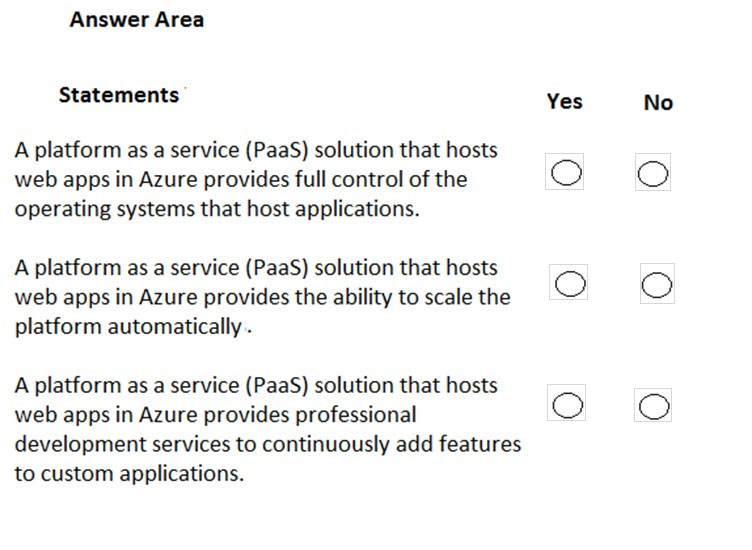
For each of the following statements, select Yes if the statement is true. Otherwise, select No.
NOTE: Each correct selection is worth one point.
Hot Area:

Correct Answer:
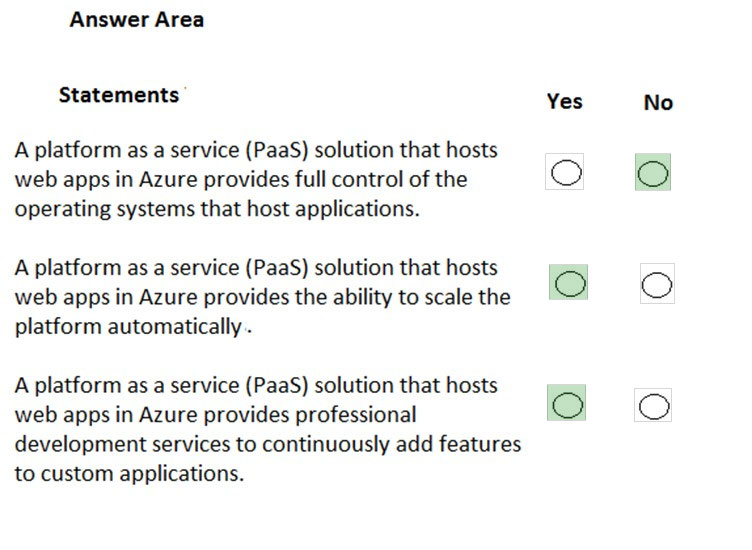
Box 1: No -
A PaaS solution does not provide access to the operating system. The Azure Web Apps service provides an environment for you to host your web applications.
Behind the scenes, the web apps are hosted on virtual machines running IIS. However, you have no direct access to the virtual machine, the operating system or
IIS.
Box 2: Yes -
A PaaS solution that hosts web apps in Azure does provide the ability to scale the platform automatically. This is known as autoscaling. Behind the scenes, the web apps are hosted on virtual machines running IIS. Autoscaling means adding more load balanced virtual machines to host the web apps.
Box 3: Yes -
PaaS provides a framework that developers can build upon to develop or customize cloud-based applications. PaaS development tools can cut the time it takes to code new apps with pre-coded application components built into the platform, such as workflow, directory services, security features, search and so on.
References:
https://azure.microsoft.com/en-gb/overview/what-is-paas/

Box 1: No -
A PaaS solution does not provide access to the operating system. The Azure Web Apps service provides an environment for you to host your web applications.
Behind the scenes, the web apps are hosted on virtual machines running IIS. However, you have no direct access to the virtual machine, the operating system or
IIS.
Box 2: Yes -
A PaaS solution that hosts web apps in Azure does provide the ability to scale the platform automatically. This is known as autoscaling. Behind the scenes, the web apps are hosted on virtual machines running IIS. Autoscaling means adding more load balanced virtual machines to host the web apps.
Box 3: Yes -
PaaS provides a framework that developers can build upon to develop or customize cloud-based applications. PaaS development tools can cut the time it takes to code new apps with pre-coded application components built into the platform, such as workflow, directory services, security features, search and so on.
References:
https://azure.microsoft.com/en-gb/overview/what-is-paas/
send
light_mode
delete
Question #35
HOTSPOT -
For each of the following statements, select Yes if the statement is true. Otherwise, select No.
NOTE: Each correct selection is worth one point.
Hot Area:
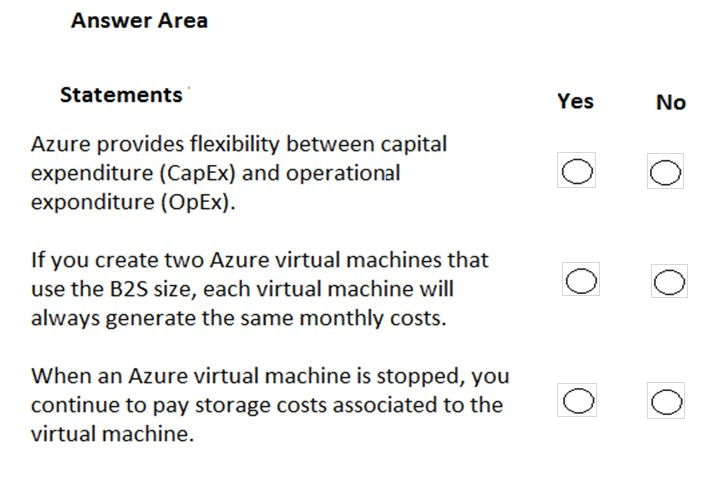
For each of the following statements, select Yes if the statement is true. Otherwise, select No.
NOTE: Each correct selection is worth one point.
Hot Area:

Correct Answer:
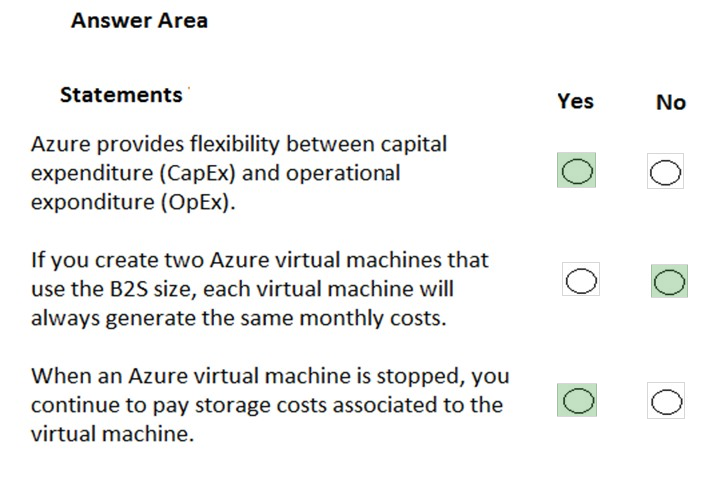
Box 1: Yes -
Traditionally, IT expenses have been considered a Capital Expenditure (CapEx). Today, with the move to the cloud and the pay-as-you-go model, organizations have the ability to stretch their budgets and are shifting their IT CapEx costs to Operating Expenditures (OpEx) instead. This flexibility, in accounting terms, is now an option due to the ג€as a Serviceג€ model of purchasing software, cloud storage and other IT related resources.
Box 2: No -
Two virtual machines using the same size could have different disk configurations. Therefore, the monthly costs could be different.
Box 3: Yes -
When an Azure virtual machine is stopped, you don't pay for the virtual machine. However, you do still pay for the storage costs associated to the virtual machine.
The most common storage costs are for the disks attached to the virtual machines. There are also other storage costs associated with a virtual machine such as storage for diagnostic data and virtual machine backups.
References:
https://meritsolutions.com/capex-vs-opex-cloud-computing-blog/

Box 1: Yes -
Traditionally, IT expenses have been considered a Capital Expenditure (CapEx). Today, with the move to the cloud and the pay-as-you-go model, organizations have the ability to stretch their budgets and are shifting their IT CapEx costs to Operating Expenditures (OpEx) instead. This flexibility, in accounting terms, is now an option due to the ג€as a Serviceג€ model of purchasing software, cloud storage and other IT related resources.
Box 2: No -
Two virtual machines using the same size could have different disk configurations. Therefore, the monthly costs could be different.
Box 3: Yes -
When an Azure virtual machine is stopped, you don't pay for the virtual machine. However, you do still pay for the storage costs associated to the virtual machine.
The most common storage costs are for the disks attached to the virtual machines. There are also other storage costs associated with a virtual machine such as storage for diagnostic data and virtual machine backups.
References:
https://meritsolutions.com/capex-vs-opex-cloud-computing-blog/
send
light_mode
delete
Question #36
HOTSPOT -
To complete the sentence, select the appropriate option in the answer area.
Hot Area:
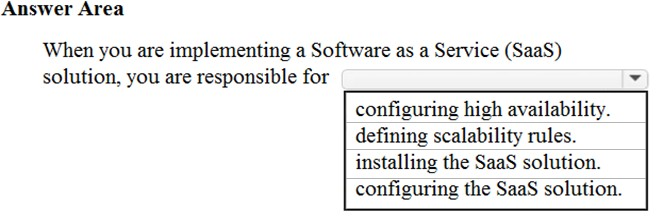
To complete the sentence, select the appropriate option in the answer area.
Hot Area:

Correct Answer:
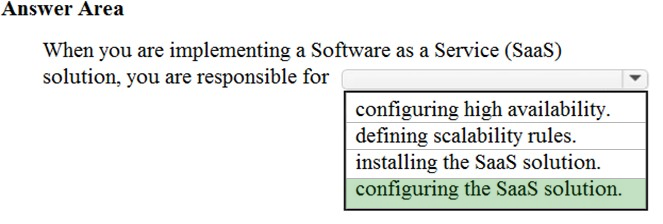
When you are implementing a Software as a Service (SaaS) solution, you are responsible for configuring the SaaS solution. Everything else is managed by the cloud provider.
SaaS requires the least amount of management. The cloud provider is responsible for managing everything, and the end user just uses the software.
Software as a service (SaaS) allows users to connect to and use cloud-based apps over the Internet. Common examples are email, calendaring and office tools
(such as Microsoft Office 365).
SaaS provides a complete software solution which you purchase on a pay-as-you-go basis from a cloud service provider. You rent the use of an app for your organization and your users connect to it over the Internet, usually with a web browser. All of the underlying infrastructure, middleware, app software and app data are located in the service provider's data center. The service provider manages the hardware and software and with the appropriate service agreement, will ensure the availability and the security of the app and your data as well.
Reference:
https://azure.microsoft.com/en-in/overview/what-is-saas/
https://docs.microsoft.com/en-gb/learn/modules/principles-cloud-computing/5-types-of-cloud-services

When you are implementing a Software as a Service (SaaS) solution, you are responsible for configuring the SaaS solution. Everything else is managed by the cloud provider.
SaaS requires the least amount of management. The cloud provider is responsible for managing everything, and the end user just uses the software.
Software as a service (SaaS) allows users to connect to and use cloud-based apps over the Internet. Common examples are email, calendaring and office tools
(such as Microsoft Office 365).
SaaS provides a complete software solution which you purchase on a pay-as-you-go basis from a cloud service provider. You rent the use of an app for your organization and your users connect to it over the Internet, usually with a web browser. All of the underlying infrastructure, middleware, app software and app data are located in the service provider's data center. The service provider manages the hardware and software and with the appropriate service agreement, will ensure the availability and the security of the app and your data as well.
Reference:
https://azure.microsoft.com/en-in/overview/what-is-saas/
https://docs.microsoft.com/en-gb/learn/modules/principles-cloud-computing/5-types-of-cloud-services
send
light_mode
delete
Question #37
You have an on-premises network that contains several servers.
You plan to migrate all the servers to Azure.
You need to recommend a solution to ensure that some of the servers are available if a single Azure data center goes offline for an extended period.
What should you include in the recommendation?
You plan to migrate all the servers to Azure.
You need to recommend a solution to ensure that some of the servers are available if a single Azure data center goes offline for an extended period.
What should you include in the recommendation?
- Afault toleranceMost Voted
- Belasticity
- Cscalability
- Dlow latency
Correct Answer:
A
Fault tolerance is the ability of a system to continue to function in the event of a failure of some of its components.
In this question, you could have servers that are replicated across datacenters.
Availability zones expand the level of control you have to maintain the availability of the applications and data on your VMs. Availability Zones are unique physical locations within an Azure region. Each zone is made up of one or more datacenters equipped with independent power, cooling, and networking. To ensure resiliency, there are a minimum of three separate zones in all enabled regions. The physical separation of Availability Zones within a region protects applications and data from datacenter failures.
With Availability Zones, Azure offers industry best 99.99% VM uptime SLA. By architecting your solutions to use replicated VMs in zones, you can protect your applications and data from the loss of a datacenter. If one zone is compromised, then replicated apps and data are instantly available in another zone.
References:
https://docs.microsoft.com/en-us/azure/virtual-machines/windows/manage-availability
A
Fault tolerance is the ability of a system to continue to function in the event of a failure of some of its components.
In this question, you could have servers that are replicated across datacenters.
Availability zones expand the level of control you have to maintain the availability of the applications and data on your VMs. Availability Zones are unique physical locations within an Azure region. Each zone is made up of one or more datacenters equipped with independent power, cooling, and networking. To ensure resiliency, there are a minimum of three separate zones in all enabled regions. The physical separation of Availability Zones within a region protects applications and data from datacenter failures.
With Availability Zones, Azure offers industry best 99.99% VM uptime SLA. By architecting your solutions to use replicated VMs in zones, you can protect your applications and data from the loss of a datacenter. If one zone is compromised, then replicated apps and data are instantly available in another zone.
References:
https://docs.microsoft.com/en-us/azure/virtual-machines/windows/manage-availability
send
light_mode
delete
Question #38
HOTSPOT -
To complete the sentence, select the appropriate option in the answer area.
Hot Area:

To complete the sentence, select the appropriate option in the answer area.
Hot Area:

Correct Answer:

A private cloud is hosted in your datacenter. Therefore, you cannot close your datacenter if you are using a private cloud.
A public cloud is hosted externally, for example, in Microsoft Azure. An organization that hosts its infrastructure in a public cloud can close its data center.
Public cloud is the most common deployment model. In this case, you have no local hardware to manage or keep up-to-date ג€" everything runs on your cloud provider's hardware.
Microsoft Azure is an example of a public cloud provider.
In a private cloud, you create a cloud environment in your own datacenter and provide self-service access to compute resources to users in your organization.
This offers a simulation of a public cloud to your users, but you remain completely responsible for the purchase and maintenance of the hardware and software services you provide.
Reference:
https://docs.microsoft.com/en-gb/learn/modules/principles-cloud-computing/4-cloud-deployment-models

A private cloud is hosted in your datacenter. Therefore, you cannot close your datacenter if you are using a private cloud.
A public cloud is hosted externally, for example, in Microsoft Azure. An organization that hosts its infrastructure in a public cloud can close its data center.
Public cloud is the most common deployment model. In this case, you have no local hardware to manage or keep up-to-date ג€" everything runs on your cloud provider's hardware.
Microsoft Azure is an example of a public cloud provider.
In a private cloud, you create a cloud environment in your own datacenter and provide self-service access to compute resources to users in your organization.
This offers a simulation of a public cloud to your users, but you remain completely responsible for the purchase and maintenance of the hardware and software services you provide.
Reference:
https://docs.microsoft.com/en-gb/learn/modules/principles-cloud-computing/4-cloud-deployment-models
send
light_mode
delete
Question #39
What are two characteristics of the public cloud? Each correct answer presents a complete solution.
NOTE: Each correct selection is worth one point.
NOTE: Each correct selection is worth one point.
- Adedicated hardware
- Bunsecured connections
- Climited storage
- Dmetered pricingMost Voted
- Eself-service managementMost Voted
Correct Answer:
DE
With the public cloud, you get pay-as-you-go pricing ג€" you pay only for what you use, no CapEx costs.
With the public cloud, you have self-service management. You are responsible for the deployment and configuration of the cloud resources such as virtual machines or web sites. The underlying hardware that hosts the cloud resources is managed by the cloud provider.
Incorrect Answers:
A: You don't have dedicated hardware. The underlying hardware is shared so you could have multiple customers using cloud resources hosted on the same physical hardware.
B: Connections to the public cloud are secure.
C: Storage is not limited. You can have as much storage as you like.
References:
https://docs.microsoft.com/en-gb/learn/modules/principles-cloud-computing/4-cloud-deployment-models
DE
With the public cloud, you get pay-as-you-go pricing ג€" you pay only for what you use, no CapEx costs.
With the public cloud, you have self-service management. You are responsible for the deployment and configuration of the cloud resources such as virtual machines or web sites. The underlying hardware that hosts the cloud resources is managed by the cloud provider.
Incorrect Answers:
A: You don't have dedicated hardware. The underlying hardware is shared so you could have multiple customers using cloud resources hosted on the same physical hardware.
B: Connections to the public cloud are secure.
C: Storage is not limited. You can have as much storage as you like.
References:
https://docs.microsoft.com/en-gb/learn/modules/principles-cloud-computing/4-cloud-deployment-models
send
light_mode
delete
Question #40
HOTSPOT -
To complete the sentence, select the appropriate option in the answer area.
Hot Area:
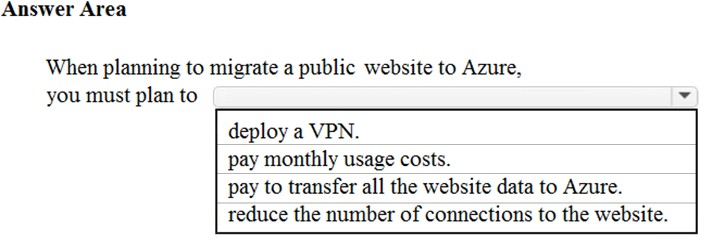
To complete the sentence, select the appropriate option in the answer area.
Hot Area:

Correct Answer:
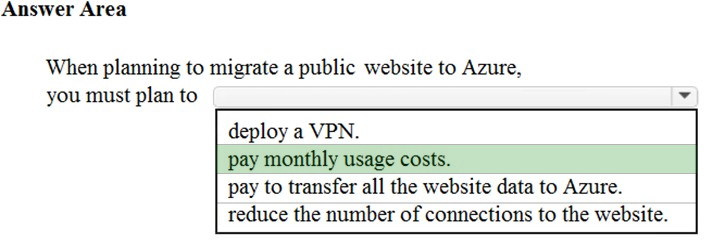
When planning to migrate a public website to Azure, you must plan to pay monthly usage costs. This is because Azure uses the pay-as-you-go model.

When planning to migrate a public website to Azure, you must plan to pay monthly usage costs. This is because Azure uses the pay-as-you-go model.
send
light_mode
delete
All Pages
